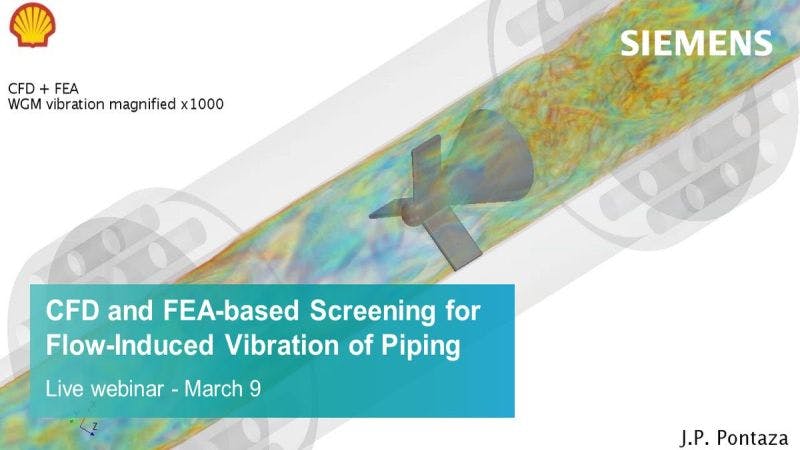Flow-induced vibration (FIV) of process piping due to multiphase internal flow poses a structural integrity concern in terms of stress cycling, especially at restricted access critical welds subsea. The ultimate concern is hydrocarbon leakage from failure due to fatigue damage. In this webinar, a three-tiered approach to FIV screening is presented, where each tier adds refinement and complexity to the assessment. The second and third-tier assessments are screening methodologies aided by Computational Fluid Dynamics (CFD) and Structural Finite Element Analysis (FEA).
CFD and FEA: the core of tier-2 and tier-3 screening
The tier-1 screening is a high-level design check on the likelihood of FIV, with no direct estimation of vibration levels, stress, or fatigue damage. The tier-3 screening is based on a one-way fluid-structure interaction (FSI) analysis. CFD is used to predict the flow-induced forces used as input loading to a structural finite element model of the piping. In the tier-2 screening, the flow-induced loading is represented by power spectral density (PSD) curves, which are inputs to a structural finite element analysis of the piping in the frequency domain. Both tier-2 and tier-3 screenings predict vibration levels and stress, from which fatigue damage may be computed.
Validating the approach and toolset for fatigue and failure screening
The webinar will include comparisons of the multiphase flow-induced forces predicted by CFD against high-quality physical laboratory measurements, with the good agreement between them serving to validate the CFD modeling approach. In addition, the vibration and stress predictions provided by the FIV screening will be compared against field measurements of vibrating pipework and shown to be in good agreement, which instills confidence in the FIV screening approach. Sample cases will also be presented, illustrating the benefits of adopting the three-tiered approach to piping FIV screening with links to business value, e.g., production reliability and uninterrupted availability.
What you will learn in this webinar:
- A three-tiered approach to assess a perceived or known FIV threat in process piping
- Assessments of increasing complexity and fidelity based on CFD and structural FEA
- Validation of CFD-predicted flow-induced loading with physical measurements
- Comparison of vibration and stress predictions with field data
- FIV screening beyond process piping
- Siemens simulations capabilities dedicated to the Oil & Gas industry
Relatori

Juan Pontaza, Ph.D.
Principal Engineer, Subject Matter Expert Fluid-Structure Interaction and CFD
Dr. Pontaza joined Shell in 2006 and is currently a Principal Engineer and the Shell subject matter expert for Fluid-Structure Interaction & Computational Fluid Dynamics. He holds BSc, MSc, and PhD degrees in Mechanical Engineering from Texas A&M University (College Station, Texas, USA) and MIT (Cambridge, Massachusetts, USA). Dr. Pontaza has authored over 40 journal and conference papers on numerical methods for fluid flow and fluid-structure interaction. He was the recipient of the 2004 Robert J. Melosh medal for best paper on Finite Element Analysis, and was recently named in the prestigious World’s Top 2% Scientist List--the list compiled by Stanford University that names the Top 2% of the most-cited scientists.

Ravi Aglave, Ph.D.
Director, Energy & Process Industries
Dr. Ravindra Aglave has over 20 years of research and engineering experience in academia and industry in the area of reactor design, scale-up and troubleshooting. His expertise includes solving engineering problems using computational fluid dynamics (CFD), mixing & reaction engineering, combustion and reaction kinetics. Dr. Aglave leads the energy and process industry sector in the Simulation & Test Solutions business unit at Siemens. He is responsible for bringing new modeling and physics knowledge in to CFD simulation code that can be deployed in the industry. Dr. Aglave has a Bachelors and Masters in Chemical Engineering and a Doctorate in Natural Sciences from University of Heidelberg, Germany. He serves on the technology operating council of AICHE and is a member of ASME, ACS and Society of Chemical Engineering Japan.
